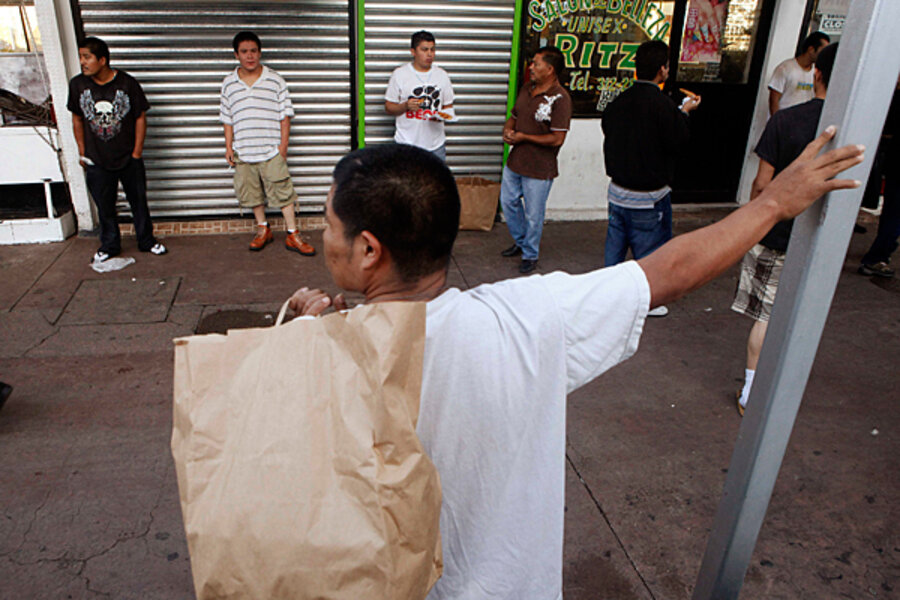Illegal immigrants: Which states have lost the most?
Loading...
The number of illegal immigrants in the United States has declined during the great recession, and the trend has been fueled by an exodus from erstwhile boom states like Arizona and Florida.
That's the message from an analysis released Wednesday by the Pew Hispanic Center, a nonpartisan research organization.
According to the report, the number of unauthorized immigrants living in the US stood at about 11.1 million in March 2009, down from 12 million in March 2007, shortly before the recession began. Although the report doesn't claim to have precise numbers, it estimates that most of the declines have occurred in a relative handful of states: Florida, New York, Arizona, New Jersey, and California.
Several of those are Sun Belt locales where a housing boom went bust, affecting the availability of jobs in construction and related fields. For example, the study suggests that the illegal immigrant population in Arizona fell by perhaps 20 percent, even before the governor signed a controversial law on the issue this year.
The Pew researchers estimate these states to have seen the largest declines in unauthorized immigrant population in 2008 and 2009:
- Florida: 675,000 illegal residents, down by 375,000.
- New York: 650,000 illegal residents, down by 150,000.
- Arizona: 375,000 illegal residents, down by 100,000.
- New Jersey: 475,000 illegal residents, down by 100,000.
- California: 2,550,000 illegal residents, down by 100,000.
Several states next on the list are also fast-growing Southern or mountain states that were hit hard by the real estate slowdown: Nevada, North Carolina, Georgia, Colorado.
In Texas, a state with many unauthorized immigrants that was not so hard hit by the downturn, the total number of illegal residents has not declined, Pew estimates.
Why are they leaving?
The Pew report merely represents an estimate, not a definitive count for the nation or any one state. But its nationwide conclusion is similar to estimates by other groups.
On Thursday, Mark Krikorian of the Center for Immigration Studies (CIS) wrote that the Department of Homeland Security has put the total number of illegal immigrants at 10.8 million as of early 2009. And the CIS has also calculated a decline in the number of illegal immigrants to 10.8 million.
"The decline started before the recession, in response to the stirrings of enforcement activity at the tail-end of the Bush administration, and then was accelerated by the economic downturn," writes Mr. Krikorian.
To advocates of stronger enforcement, including the CIS, the decline since 2007 is a sign that better border patrol and other measures can result in progress on what has seemed to many Americans to be an intractable problem. At the same time, to the degree that the reduction relates to a poor economy, pressure on America's borders could quickly reverse if and when the job market improves.
Even if the overall number of illegal immigrants in the US has declined by 1 million or more since 2007, illegal immigrants remain a significant presence as a share of both the overall US population (3.7 percent) and the labor force (5.1 percent).
The states with the largest shares of illegal immigrants in the labor force are Nevada (9.4 percent of the work force), California (9.3 percent), Texas (8.7 percent), and New Jersey (8.7 percent).
[Editor's note: The original version of this sentence left out the word "illegal."]
In any given year, many unauthorized immigrants leave the US and many arrive. Nearly half the illegal immigrants living in the country in 2009 arrived in 2000 or later.
A campaign issue
Although jobs and unemployment have center stage in the fall congressional campaigns, immigration is as hot a political issue as ever. President Obama is working on an immigration reform proposal, while California Senate candidates Carly Fiorina (R) and incumbent Barbara Boxer (D) sparred over the issue in a debate this week.
In an August CBS News poll, 61 percent of Americans rated illegal immigration as a "very serious" issue.
Some public opinion polls have found a majority of Americans support the idea of Arizona's get-tough law, which requires people to provide documents verifying their status if asked by police. Yet polls have also found the public split over whether to focus on deportation or providing pathways toward legal residency for people in the country illegally.
The Pew Hispanic Center website offers an interactive map of the US, with data on illegal immigration in each state.





